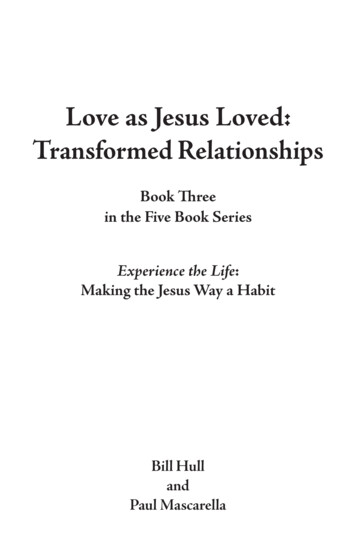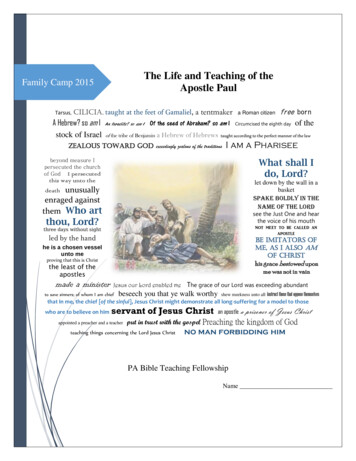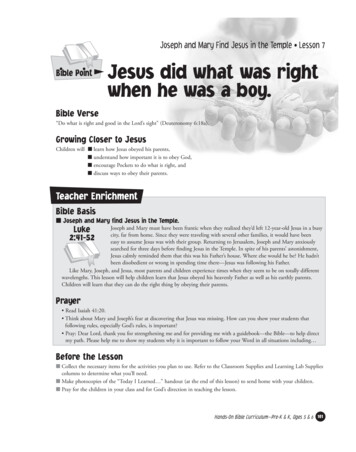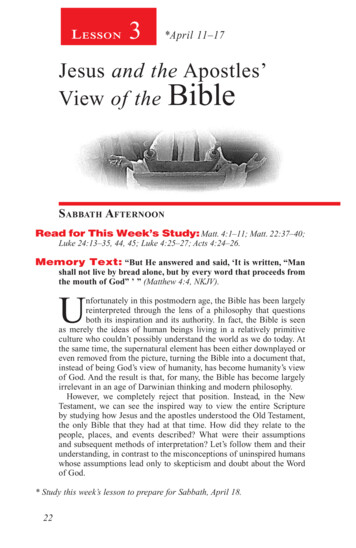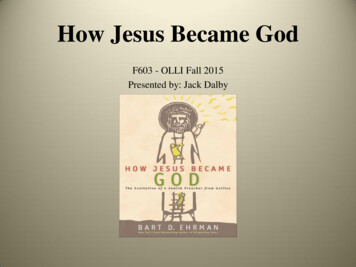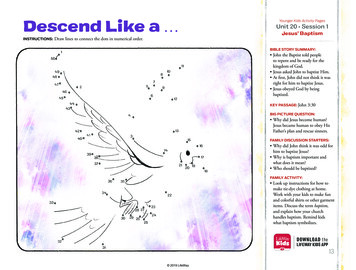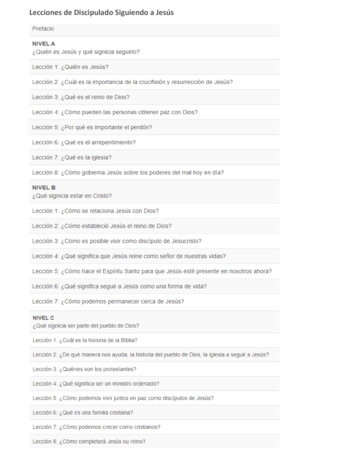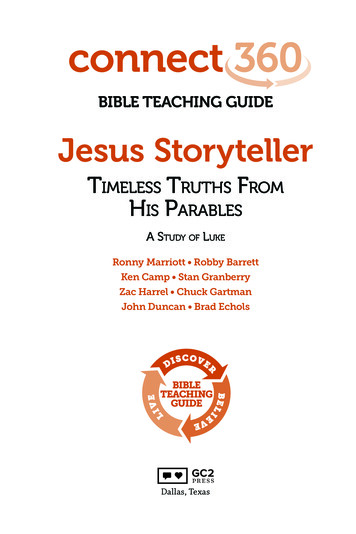
Transcription
connect 360BIBLE TEACHING GUIDEJesus StorytellerTimeless Truths FromHis ParablesA Study of LukeRonny Marriott Robby BarrettKen Camp Stan GranberryZac Harrel Chuck GartmanJohn Duncan Brad EcholsBIBLETEACHINGGUIDEDallas, Texas
Jesus Storyteller: Timeless Truths From His Parables (A Study of Luke)Connect 360 Bible Teaching GuideCopyright 2021 by GC2 Press.All rights reserved.Printed in the United States of America.No part of this book may be used or reproduced in any manner whatsoeverwithout written permission except in the case of brief quotations.For information, contactGC2 PRESS, 7557 Rambler Road, Suite 1200, Dallas, TX 75231-2388.GC2 is registered in U.S. Patent and Trademark Office.CONNECT 360 ALL THE BIBLE FOR ALL OF LIFE is registered in U.S. Patent and Trademark Office.Unless otherwise indicated, all Scripture quotations in lessons 1-13 and theChristmas lesson are taken from the Holy Bible, NEW INTERNATIONALVERSION , NIV Copyright 1973, 1978, 1984, 2011 by Biblica, Inc. Used bypermission. All rights reserved worldwide.Executive Director, BGCT: David HardageAssociate Executive Director, BGCT: Craig ChristinaTreasurer/CFO, BGCT: Ward HayesDirector, Center for Church Health, BGCT: Phil MillerPublisher, GC2 Press: Bob BillupsMarketing Coordinator, GC2 Press: Stan GranberryPublishing Specialist, GC2 Press: Nancy FeasterProduction, Cover Design, and Printing: Randall HouseFirst edition: December 2021ISBN - 978-1-948618-50-2
How to Make the Best Useof This Teaching GuideLeading a class in studying the Bible is a sacred trust. This Teaching Guidehas been prepared to help you as you give your best to this important task.In each lesson, you will find first “Bible Comments” for teachers, toaid you in your study and preparation. The three sections of “Bible Comments” are “Understanding the Context,” “Interpreting the Scriptures,” and“Focusing on the Meaning.” “Understanding the Context” provides a summary overview of the entire background passage that also sets the passagein the context of the Bible book being studied. “Interpreting the Scriptures”provides verse-by-verse comments on the focal passage. “Focusing on theMeaning” offers help with the meaning and application of the focal text.The second main part of each lesson is “Teaching Plans.” You’ll find twocomplete teaching plans in this section. The first is called the “DiscoveryPlan,” which emphasizes discovery learning techniques; and the second iscalled the “Discussion Plan,” which provides questions and suggestions fordialogue about the Scriptures. Choose the plan that best fits your class andyour style of teaching. You may also use and adapt ideas from both. Eachplan is intended to be practical, helpful, and immediately useful as you prepare to teach.The major headings in each teaching plan are intended to help yousequence how you teach to follow the flow of how people tend to learn.The first major heading, “Connect With Life,” provides ideas that will helpyou begin the class session where your class is and draw your class into thestudy. The second major heading, “Guide Bible Study,” offers suggestionsfor helping your class engage the Scriptures actively and develop a greaterunderstanding of this portion of the Bible’s message. The third major heading, “Encourage Application,” is meant to help participants focus on how torespond with their lives to this message.3
4 Jesus Storyteller: Timeless Truths From His ParablesAs you begin the study with your class, be sure to find a way to help yourclass know the date on which each lesson will be studied. You might use oneor more of the following methods: In the first session of the study, brief ly overview the study byidentifying for your class the date on which each lesson will be studied.Lead your class to write the date in the table of contents in their StudyGuides and on the first page of each lesson. Make and post a chart that indicates the date on which each lessonwill be studied. If all of your class has e-mail, send them an e-mail with the dates thelessons will be studied. Provide a bookmark with the lesson dates. You may want to includeinformation about your church and then use the bookmark as anoutreach tool, too. A model for a bookmark can be downloaded fromwww.gc2press.org under the “Teacher Helps” tab. Develop a sticker with the lesson dates, and place it on the table ofcontents or on the back cover.Here are some steps you can take to help you prepare well to teach eachlesson and save time in doing so:1. Start early in the week before your class meets.2. If your church’s adult Bible study teachers meet for lesson overview andpreparation, plan to participate. If your church’s adult Bible study teachers don’t have this planning time now, look for ways to begin. You, yourfellow teachers, and your church will benefit from this mutual encouragement and preparation.3. Overview the study in the Study Guide. Look at the table of contents andsee where this lesson fits in the overall study. Then read or review thestudy introduction to the book that is being studied.4. Consider carefully the suggested Main Idea, Question to Explore, andTeaching Aim. These can help you discover the main thrust of this particular lesson.5. Use your Bible to read and consider prayerfully the Scripture passagesfor the lesson. Using your Bible in your study and in the class session
How to Make the Best Use of This Teaching Guide 5can provide a positive model to class members to use their own Biblesand give more attention to Bible study themselves. (Each writer of theBible comments in both the Teaching Guide and the Study Guide haschosen a favorite translation. You’re free to use the Bible translation youprefer and compare it with the translations chosen, of course.)6. After reading all the Scripture passages in your Bible, then read theBible comments in the Study Guide. The Bible comments are intendedto be an aid to your study of the Bible. Read also the small articles—”sidebars”—in each lesson. They are intended to provide additional,enrichment information and inspiration and to encourage thought andapplication. Try to answer for yourself the questions included in eachlesson. They’re intended to encourage further thought and application,and you can also use them in the class session itself. Continue your Biblestudy with the aid of the Bible comments included in this Teaching Guide.7. Review the “Teaching Plans” in this Teaching Guide. Consider how thesesuggestions would help you teach this Bible passage in your class toaccomplish the teaching aim.8. Consider prayerfully the needs of your class and think about how toteach so you can help your class learn best.9. Develop and follow a lesson plan based on the suggestions in thisTeaching Guide, with alterations as needed for your class.10. Enjoy leading your class in discovering the meaning of the Scripturepassages and in applying these passages to their lives.Premium Commentary. Plan to get the additional Bible study comments available online. Visit our website, call 1–866–249–1799, or e-mailgc2press@texasbaptists.org to order the Premium Commentary. It is availableonly in electronic format (PDF) from our website. The price of these comments is 8 per person. A church or class that participates in our advanceorder program for free shipping can receive the Premium Commentary free.Call 1–866–249–1799 or see www.gc2press.org for information on participating in our free shipping program for the next study.
6 Jesus Storyteller: Timeless Truths From His ParablesPremium Teaching Plans. An additional teaching plan is also available inelectronic format (PDF) by visiting our website or calling 1–866–249–1799.The price of these plans for an entire study is 8 per person. It is availableonly in electronic format (PDF) from our website. A church or class thatparticipates in our advance order program for free shipping can receive thePremium Teaching Plans free. Call 1–866–249–1799 or see www.gc2press.orgfor information on participating in our free shipping program for the nextstudy.FREE! Downloadable teaching resource items for use in your class are available at www.gc2press.org. Watch for them in the “Teaching Plans” for eachlesson. Then go online to www.gc2press.org and click on “Teaching ResourceItems” under the “Teacher Helps” tab for this study. These items are selectedfrom the “Teaching Plans.” They are provided online to make lesson preparation easier for handouts and similar items. Permission is granted todownload these teaching resource items, print them out, copy them asneeded, and use them in your class.
7Writers for this Teaching GuideRonny Marriott wrote the Bible Comments for lessons one through four.Dr. Marriot is Senior Pastor of First Baptist Church in Burleson, Texas. Heholds the Doctor of Ministry degree from Southwestern Baptist TheologicalSeminary. He is the former Pastor of both First Baptist Church in CorpusChristi, Texas and First Baptist Church in Temple, Texas. Ronny, who is married to Robin, has written several studies for GC2 Press.Robby Barrett wrote the Teaching Plans for lessons one through four.Dr. Barrett has served as Minister of Education at First Baptist Church inAmarillo, Texas since 1996. A graduate of Hardin-Simmons University andSouthwestern Baptist Theological Seminary, he was the first graduate of theDoctor of Ministry program at Baylor’s George W. Truett Theological Seminary. Robby previously served churches in Abilene, Lamesa, and Waco. Heand his wife, LaVon, have two sons and four grandchildren. Robby has written numerous teaching plans for GC2 Press.Ken Camp wrote the Bible Comments for lessons five through seven. Kenhas been Managing Editor of the Baptist Standard news service since January2004. Previously, he served 19 and a half years on the Baptist General Convention of Texas communications staff. He earned an undergraduate degreefrom East Texas State University in Commerce and a master’s degree fromSouthwestern Baptist Theological Seminary in Fort Worth. He and his wife,Diane, are members of South Garland Baptist Church. They have three sons;Daniel, Matthew, and Nathan; two daughters-in-law, Linsey and Devon; andfour grandchildren; Henry, Andrew, Owen, and Katherine.Stan Granberry wrote the Teaching Plans for lessons five through seven.Stan is a graduate of Baylor University (B.A.) and George W. Truett Theological Seminary (M.Div.) both in Waco, Texas. Stan has served 15 years on thestaff of Texas Baptists, the last 13 as Marketing Coordinator for GC2 Press.He previously served as a missionary in France. Stan has a son and daughterin high school and one daughter in college. He co-teaches his adult Sunday7
8 Jesus Storyteller: Timeless Truths From His ParablesSchool class at Cliff Temple Baptist Church in Dallas, and he spends his freetime playing basketball, bike riding, and cheering on the Baylor Bears.Zac Harrel wrote the Bible Comments for lessons eight through ten. Zacserves as Network Missionary for the Heart of Texas Baptist Network inEarly, Texas. He is a graduate of Howard Payne University (B.A.) and Logsdon Seminary (M.Div.). He formally served as Youth Minister at First BaptistChurch in Port Aransas, Texas and as Pastor at First Baptist Church in Gustine, Texas. Zac is married to Shandra, and they have two children.Chuck Gartman wrote the Teaching Plans for lessons eight through ten.Chuck serves as the Director of Ministry Guidance and as an AssistantProfessor of Christian Studies at Howard Payne University in Brownwood,Texas. Chuck has served in a variety of local churches, universities, seminaries, and denominational entities. He has distinguished himself as an expertin local church student ministry, and in numerous other aspects of churchleadership. Chuck and his wife, Connie, have three grown daughters.John Duncan wrote the Bible Comments for lessons eleven through thirteen and the Christmas lesson. Dr. Duncan is the Co-Pastor of The Churchat Horseshoe Bay in Horseshoe Bay, Texas. He has a Ph.D. from The OpenUniversity via the Kirby-Laing Institute in Cambridge, UK, and a D.Min.from Southwestern Baptist Theological Seminary in Fort Worth, Texas.John is married to Judy, has three married daughters, and three grandbabies. He is also an avid basketball fan of the NBA’s Dallas Mavericks.Brad Echols wrote the Teaching Plans for lessons eleven through thirteenand the Christmas lesson. Brad serves as Youth Minister at First BaptistChurch in Belton, Texas. He has a Master of Arts in Youth Ministry fromHoward Payne University in Brownwood, Texas. Brad has held a variety ofroles in serving the local church including conference speaker, serving ondenominational committees, and adjunct professor at Howard Payne University. Brad and his wife, Erin, have three children: Macie, Beckett, andHenry.
9Jesus Storyteller:Timeless Truths from His ParablesA Study of LukeHow to Make the Best Use of This Issue Teaching Guide3Writers for This Teaching Guide7Introducing GC2 Press11DATE OF STUDYLESSON 1 Parties, Patches, and Wineskins12LUKE 5:33-39LESSON 2 How to Build a Storm-Proof Life24LUKE 6:46-49LESSON 3 How to Cultivate a Teachable Heart35LUKE 8:1-15LESSON 4 Love—Like a Good Neighbor47LUKE 10:25-37LESSON 5 Prayer That Just Won’t Quit58LUKE 11:5-13LESSON 6 A Fool’s Formula for Failure67LUKE 12:13-21LESSON 7 Why Do Good People Suffer?76LUKE 13:1-9LESSON 8 Excuses: The Skin of a ReasonStuffed With a Lie86LUKE 14:12-24LESSON 9 What Makes Heaven Happy?LUKE 15:1-1098
Jesus Storyteller: Timeless Truths From His Parables10 LESSON 10 What Is God Really Like?110LUKE 15:11-24LESSON 11 How Much Can God Trust You?123LUKE 16:1-18LESSON 12 The Peril of Proud Praying134LUKE 18:9-14LESSON 13 Use It or Lose It146LUKE 19:11-27Christmas The Surprising Truth About God158LUKE 20:9-19Prayer for This Study169How to Order More Bible Study Materials170Ministry Promotions172
11We’ve Changed Our Name!BaptistWay Press has now become GC2 Press. The name change reflectsthe alignment with our state convention’s (BGCT) recently updated missionstatement. GC2 is a movement of God’s people to share Christ and showlove. Our driving passion is to follow the Lord’s call to fulfill the Great Commission “to share Christ” and the Great Commandment “to show love.” TheGreat Commission and the Great Commandment form the two “GCs,” orGC2.GC2 Press will continue to publish the undated CONNECT 360 quarterlyBible study curriculum. Connect 360 has gained a reputation for solid biblical teaching and will continue to be published as an undated quarterly studyavailable in book form and/or digital downloads. Connect 360 is currentlybeing distributed in 38 states and 16 countries and has been translated intoseven different languages.
Focal TextBackgroundLuke 5:33-392 Corinthians 5:17;John 1:17lesson1Parties, Patches, andWineskinsMAIN IDEAYou may not die from hardening ofthe arteries, but you can suffer fromhardening of the attitudes.QUESTION TO EXPLOREHow can your attitude be more joyfuland how can you grow more likeChrist in all areas of your life?TEACHING AIMBIBLESTUDYGUIDETo lead participants to identify wayswe are losing our joy and souring ourattitude when we cling to our oldways, instead of looking for and celebrating the new things God is doingin our lives
Lesson 1: Parties, Patches, and Wineskins 13Bible CommentsUnderstanding the ContextLuke described in chapters five and six of his gospel, some of the controversies Jesus faced because of the Pharisees. The Pharisees accused Jesus andHis followers of violating laws regarding fasting and keeping the Sabbath.Jesus upset the Pharisees by eating with sinners and tax collectors, so theywere constantly looking for ways to expose Jesus as a fake or cause doubt inHis followers as to His identity. The main issues they had with Jesus wereover the Law. The Pharisees spent a lot of time and effort accusing Jesus andHis followers of breaking the Mosaic Law; a law they were tasked to promoteand protect. The Pharisees were upset with Jesus because He spoke with authority and what He taught was different from what they taught.People followed Jesus’ teaching because it was new and authoritative;they were unfamiliar with His way of teaching and His knowledge of the Law.He taught in a way common people could understand. John 1:17 states thatthe Law came from Moses, but grace and truth came from Jesus. The apostle Paul wrote in 2 Corinthians 5:17 that a person is made new through arelationship with Jesus. The Law made it clear that people need to be transformed and Jesus came to make transformation possible. He did not come topatch things up, He came to make things new.On this occasion, Jesus used three images to make His point: a wedding,clothing, and wine skins. Jesus used these three images to illustrate He wasushering a new way to relate to God. This new way required an open mind toa new way of thinking about God and how He related to people.Interpreting the ScripturesThe Question (5:33)Jesus attended a banquet at the home of Levi the tax collector. Someone atthe banquet noticed a difference in fasting practices between the disciples of
14 JESUS STORYTELLER: Timeless Truths From His ParablesJohn, the Pharisees, and of Jesus. Jews viewed fasting as a virtue of Judaismand Pharisees and their disciples practiced it regularly. Jews normally fastedfor one day, however, fasting could last anywhere from one to forty days.Jews often observed it in conjunction with major Jewish festivals. Fasting included going without food and replacing the normal time eating with prayerand reflection on God. Pharisees felt it was so important they regularly fastedtwice a week. Although fasting is not commanded in the New Testament, thegospels do record Jesus fasting for forty days just before Satan tempted Him.The Pharisees viewed Jesus and His disciples lack of regular fasting as disrespectful to God, the Law, and to Judaism.Jews believed that keeping the Law was required to please God. Oneresponsibility of Pharisees, Sadducees, and other religious leaders involvedkeeping and enforcing the Law. Jewish leadership imposed other laws in addition to the laws God gave to His people the Israelites. These laws were oftenused to control and oppress the people of God. Religious leaders also usedthese laws in several attempts to trap Jesus and silence Him. Interestingly,several Jewish laws were broken by the High Priest and others during Jesus’arrest, trials, and crucifixion.The Response (5:34-39)5:34-35. Jesus answered the question with an illustration of a Jewishwedding. He took the opportunity to reveal something about Himself. It ishelpful to know something about Jewish wedding customs to understandJesus’ meaning. In Jewish culture, engagement and betrothal were not thesame thing. Engagements could be broken but betrothals were consideredas binding as marriage. In fact, betrothal included the families of the brideand groom meeting together, a ring or something of value was given to thebride to be, and the couple even signed an agreement of marriage. After thebetrothal, the groom would leave his fiancée to build or prepare a room ontohis parent’s house where the new couple would eventually live. After oneyear, when the new edition was complete, the groom to be would arrive atthe bride’s house to whisk her away and take her to the wedding. The groomdressed like a king and her maidens adorned the bride with jewelry and braid-
Lesson 1: Parties, Patches, and Wineskins 15ed her hair. She dressed like a queen. The parents of the bride blessed herbefore she left, and she along with her groom would go back to his house forthe wedding and celebration. The families of the bride and groom hosted aweeklong celebration for the newlyweds, their families, and friends after thewedding.Another marked difference between the disciples of the Pharisees andthe disciples of Jesus was joy. The bridegroom in this parable is Jesus. Likethe arrival of the bridegroom, the presence of Jesus brought joy to His followers. No one would observe a fast in the presence of the bridegroom at thewedding, and no one should fast in the presence of the long-awaited Messiah.A fast was a somber experience centered around sacrifice and suffering fromgoing without food. Weddings centered around extravagance and celebration.Jesus made His point, the arrival of the groom to get the bride triggered thecelebration. The event brought joy, not sorrow. Even the guests were dressedin wedding garments. The joy and celebration lasted for a week and there wasalso what was known as the days of marriage, which lasted thirty days.After the celebrations ended, it was appropriate for a Jew to observefasts again. Jesus is the groom in this story. While He was with them, Jesus’followers experienced joy. He alluded to the fact He would one day be takenaway from His disciples by rejection and death, this would cause sorrow. Atthat point, it would be appropriate to resume the discipline of fasting.5:36. Jesus used a second illustration of sewing a new patch on an oldgarment to show He did not come to patch up the old Jewish religion; Hebrought something new. Clothing in the Bible often is used as a metaphor torepresent character and conduct.Most of the people living in Jesus’ day were poor, they did not have theluxury of buying new clothes when they ripped a hole or had a tear in theirclothes. Instead, they cut out a patch from a piece of material and sewed iton the old garment to cover the hole. This created a problem if the patchwas made from new material and sewn on an old garment. When the personwashed the old garment containing the new patch, the patch would shrinkand tear away from the old material thereby causing a larger hole in the garment. Unfortunately, things like pre-washed jeans did not exist so adjust-
16 JESUS STORYTELLER: Timeless Truths From His Parablesments had to be made. Patching an old garment with an old patch was a wiseway to repair the garment.Another way to put this is do not combine the old with the new. Jesusbrought new ways and new perspectives that could not simply be added on tothe old ways. This would prove ineffective. Jesus’ new ways needed a new wayof thinking and living. Jesus is not just a new patch we can attach to our oldlife. Jesus makes all things new. The Bible says in 2 Corinthians 5:17, “Therefore, if anyone is in Christ, the new creation has come: The old has gone, thenew is here!” Jesus does not simply reform people, He transforms people.5:37-39. Jesus used wine and wineskins as a third way to illustrate Hispoint. Wine was common, and wine was stored in something called wineskins. People made wineskins out of sheep or goat hide. The neck of the animal served as a spout to pour wine in or out of the container. Wine fermentedin the wineskins created gasses, which caused the hides to expand. If thewineskin was old, dry, or brittle, the container could burst from the expanding gases ruining the wineskin and spilling the wine. New flexible wineskinscould expand to accommodate the fermenting wine. New wine could only bestored in new wineskins.Jesus’ illustration revealed that the old Jewish religion could not containthe new life of the Spirit Jesus brought. Jesus came not to destroy the Lawbut to fulfill the Law. The final sacrifice was Jesus, and He ended the need forsacrifices. Jesus became the final High Priest; there was no need for anotherone. Jesus brought lasting joy to the world through salvation. John wrotein John 1:17, “For the law was given through Moses; grace and truth camethrough Jesus Christ.”Jesus challenged the thinking of the Jews who thought a certain way fora long time. Receiving Jesus’ new teaching, like new wine, required His listeners to have a flexible mind to comprehend. A rigid stubborn mind missedthe point of Jesus.
Lesson 1: Parties, Patches, and Wineskins 17Focusing on the MeaningThe contemporary Christian worship movement in America began manyyears ago. In addition to a traditional service that included hymns, choir, orchestra, piano, and organ, churches added a service including praise songs,drums, guitars, and a worship band. This change led to what was known asworship wars. Christians debated the right way to worship God. Some Christians got excited about a new way to worship God. Others believed the newway did not belong in the church. Many feared what might happen to thechurch and to theology if hymns were removed from worship. This struggleover the changes led to church splits, new church starts, and heated discussions.Today, some churches only conduct traditional worship services, someonly contemporary worship, and some have a blend of both hymns and praisesongs in one service. Other churches hold different style worship services inthe same location. Apparently, although Christians still have differing opinions regarding worship styles, the war seems to be over.Someone said the eight deadliest words in the church are, “We have never done it that way before.” There is truth to the statement. Perhaps just asdeadly is a Christian who says, “I have never seen God do things that wayso this must not be God.” Supporters of both traditional worship and contemporary worship were guilty of becoming rigid and brittle in their way ofthinking, believing their way of worshipping to be the only true worship. Thebelief that contemporary worship is not true worship, or traditional worshipis outdated are evidence of old wineskin thinking.Christians battling over preferences is an example of the good wine spilling out and being wasted. Focusing on our preferences rather than whereGod is at work can cause a Christian to miss out on the movement of God.God is the same yesterday, today, and tomorrow. However, He is constantlydoing a new thing by revealing more of Himself to His children. He is workingin ways we have not personally seen before. Christians must be diligent totest everything against the Word of God but not be so rigid in our thinkingthat we miss what God wants to do in our lives.
18 JESUS STORYTELLER: Timeless Truths From His ParablesBIBLIOGRAPHYBrock, Darrell L. The NIV Application Commentary, Luke, (Grand Rapids, MI:Zondervan, 1996).Good, R.S. Jesus, Protagonist of the Old, in LK 5:33-39, Novum TestamentumVol. 25, no. 1, 1983.Wiersbe, Warren W. The Bible Exposition Commentary, Volume 1 Matthew—Galatians, (Wheaton, IL: Victor Books, 1989).
Lesson 1: Parties, Patches, and Wineskins 19Teaching PlansDISCOVERY PLANConnect With Life1. Use the information in the Study Guide Introduction to describe a parable. You may want to take an onion (sealed in a baggie) to class and peelseveral layers of the onion away as you define surface truth, spiritualtruth, and personal truth as presented by the lesson writer. Point outthat Jesus was the master storyteller, and we will explore Hs words thatmade such a difference in the life of His hearers.2. To introduce Luke 5:33-39, invite members to discuss clothing stylesthat were popular when they were in high school. Round up a few oldgarments to display during the discussion. Encourage conversation byasking: What was your favorite piece of clothing in high school? How have clothing styles changed since you were in high school? How have styles stayed the same? What has come back in style? When is a garment too old to wear? When is a garment too old to patch or repair? What is the last garment you have tried to repair? Someone in theclass will probably note that no one patches jeans these days!3. Comment that in today’s study Jesus talked about the difficulty ofpatching old cloth (and wineskins) with new cloth, but He may havebeen presenting a much deeper meaning.
20 JESUS STORYTELLER: Timeless Truths From His ParablesGuide Bible Study4. Invite a member to read Luke 5:33-35 aloud. Point out that this question from the religious leaders about Jesus’ disciples eating and drinking rather than fasting, follows their question about Jesus’ eating anddrinking with tax collectors and sinners. Ask, What do you think the realquestion is here? What is the real concern of the Pharisees and their scribes?Why did Jesus respond with an example of a wedding?5. Ask class members to brainstorm characteristics of a joyful life, andthe source of these characteristics. List responses on a markerboardfor later use. Then ask the class to consider times when sorrow, suffering, pain, and disappointment seem to overtake or cloud our joy. Invitethe group to consider how these verses speak to those occasions. Sharethis statement from the study guide: If you compare the Christian life to asong, the melody is always joy and praise. The harmony line is suffering andpain.6. Form two or three discussion groups within the class (as size allows).Ask each group to read verses 36-39, and consider the following: What was Jesus saying about new and old in these verses? What are some traditions in our church that could be consideredold? What are some newer practices in our church? What are some old things in a person’s life that could cloud the joyof his or her walk with Christ? How does focusing on the “new” allow us to see the work of Christmore clearly? How did Jesus replace the old with the new? Did Jesus come topatch things up, or make all things new? How does this passage speak to the Old and New Covenants?(A copy of this assignment is available in “Teaching Resource Items”for this study at www.gc2press.org).
Lesson 1: Parties, Patches, and Wineskins 217. Have a previously enlisted class member read aloud and share a fewthoughts from 2 Corinthians 5:17. Then ask the entire group to consider how this passage further speaks to the parable of Jesus in Luke5:33-39. Allow time for discussion.Encourage Application8. Invite groups (step 6) to identify and pr
4 Jesus Storyteller: Timeless Truths From His Parables As you begin the study with your class, be sure to find a way to help your class know the date on which each lesson will be studied. You might use one or m


